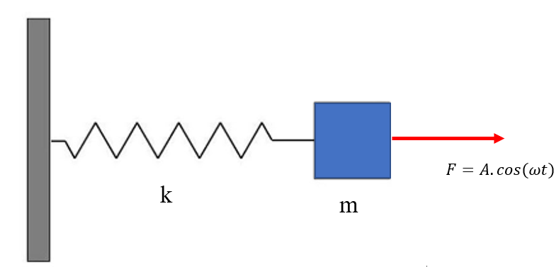To introduce resonance, we usually find in elementary Physics lectures the following system"

The solution of which is: $$\begin{cases}x(t)= \frac{A}{ \omega^2-\omega^2_{0}}sin(\omega~t) ~~~~\omega \neq \omega_{0} \\x(t)= \frac{A}{2m \omega_{0}}.t.sin(\omega_{0}~t) ~~~~\omega =\omega_{0}\end{cases}$$
One generally invokes damping to overcome the diverging amplitude of the solution. But if we model the external force generator by a spring-mass oscillator, the unbounded amplitude of the solution disappears.
My claim is that the classical explanation for resonance does not cover all cases. It is perfectly possible to have a mass-spring system driven at the resonance frequency by a generator, without the system exhibiting unbounded amplitude. The determining factor is not only the frequencies of the generator and system, but also the coupling between the two systems.
There are two possible couplings. The rigid and the soft one.
Rigid coupling
The generator is the mass-spring system in the dashed box on the right. It is connected to the oscillating mass-spring system on the left by a rigid rod.
We chose the coefficient $\alpha$ to be very large to insure an ample amount of energy in our generator and minimize any feedback effects. This generator oscillates at the eigen frequency $\omega_{0}=\sqrt{ \frac{k}{m} } $ of the mass-spring system. So the oscillations of the mass m should exhibit the resonance as in the previous case. But it does not.
This system is equivalent to a mass coupled to two different springs in parallel.

The solution is well known and is non resonant. For the mass m, one gets:
$$ x(t)=A~cos(\omega_{0}~t+ \varphi )$$
This generator oscillates at $\omega_{0}$ both unloaded and loaded and can drive the spring-mass (k, m) without having the amplitude diverging. The result is independent of $\alpha$.
For the second model, the spring-mass generator is connected by a coupling spring $k_{c}$ to the oscillating mass.
Soft coupling
Again, the unloaded generator oscillates at $\omega_{0}$ and has sufficient energy and inertia both controlled by $\alpha$. The solution is again well known. it reads:
$$ \beta = \frac{k_c}{m} $$
$$ x_{m}(t)= \frac{{x_M}(0) \alpha }{ \alpha +1} \big(cos( \omega _{0}~t) -cos( \sqrt{\frac{ \alpha~\omega^{2} _{0}+ \alpha . \beta + \beta }{ \alpha } } t)\big) $$
And for the generator:
$$ x_{M}(t)= \frac{{x_M}(0) \alpha }{ \alpha +1} \big( cos( \omega _{0}~t) - \frac{1}{\alpha} cos( \sqrt{\frac{ \alpha~\omega^{2} _{0}+ \alpha . \beta + \beta }{ \alpha } } t)\big) $$
A series expansion in terms of $\beta$ and $\alpha$ gives:
$$\begin{cases} \beta \mapsto 0 \\\alpha \longrightarrow \infty\end{cases} \Longrightarrow ~~x_{m}(t)= \frac{ \beta x_{M}(0)}{2 \omega _{0}} t.sin(\omega _{0}~t)+O( \frac{1}{ \alpha })O( \beta^{2} )$$
So we recover the ever growing amplitude of the classical resonance. However, it is just an approximation, the full solution does not grow for ever. A closer analysis shows a two frequencies beat response, the ever growing amplitude of the solution is just an approximation at the origin of the envelope by its tangent. It is noticeable that in this case, the frequency of the generator changes, indicating that the energy is flowing back into the generator.
Conclusion
The frequency of the generator matching the frequency of the oscillator is necessary but not sufficient for the resonance to occur. The controlling factor is the coupling between the two systems.
My question:
- Did I go wrong somewhere?
- What would be the equivalent of a hard/ soft coupling in electricity?
- Any references on the subject would be welcome.


